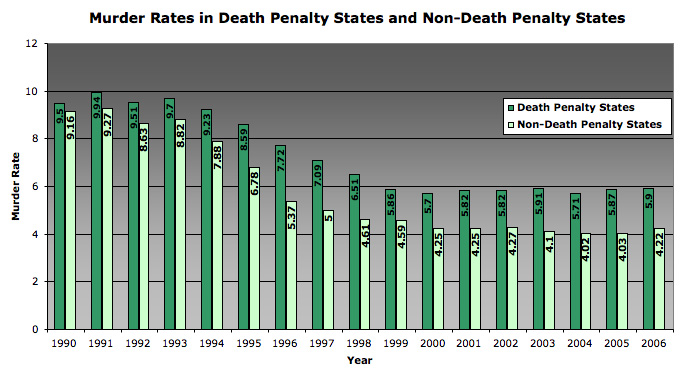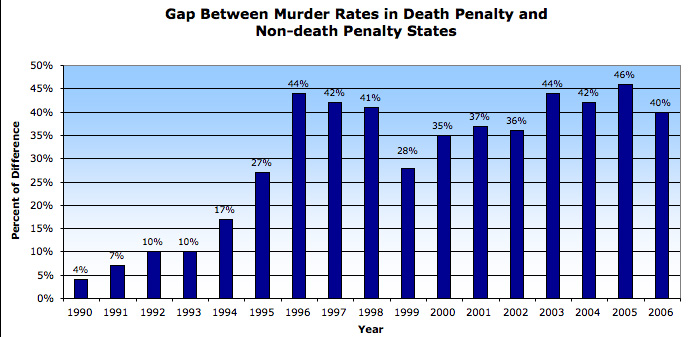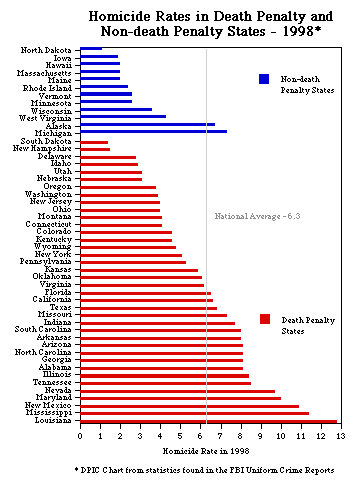The use of the death penalty as a deterrent
Since time immemorial, there has always been a system of crime and punishment, though the intensity and administration of punishment have varied through the ages. It was believed that fear of punishment would ensure that the crime was not repeated. It is this analogy that justifies the death penalty as a deterrent to crime. Whether or not it is, forms the focus of this project.
Convicted men and women found guilty of crimes ranging from petty theft to mass murder were paraded before the rest of the community, publicly humiliated, and then killed quite gruesomely. This was found to be perfectly normal as there was this general belief that the person deserved the punishment meted out. For instance, The Old Testament advocated punishment by death that would serve not only as a deterrent but also a kind of collective purging of guilt that a particular community felt about the crimes committed in the past. Stuart Banner has quoted from the Bible thus, “and the land cannot be cleansed of the blood that is shed therein, but by the blood of him that shed it.”(Banner, 2002). The reference was to the age-old practice of handing out capital punishment in the presence of an entire community. This served as a deterrent mainly because of the gory way in which the punishment was carried out. It is also worth mentioning that such trials were conducted with incredible speed, leaving no time for reconsideration of the sentence served. The severity of the punishment combined with the speed at which the same was arrived at could have two more effects. One would be to deter people from committing crimes that would attract such penalties. The other would force otherwise silent convicts to plead guilty of crimes, a line of action that they had not taken till then. They would do this in the fervent hope that some amount of clemency would be shown and the severity of their sentences would be mitigated.
The death penalty – an active deterrent to crime
Fear of death is certainly one of the primeval fears of not just human beings but of all life forms. The success achieved in a desperate fight for survival is what sets apart a species that still exists on the planet, and man is no exception to this universally accepted fact. In days gone by, the manner in which criminals were dealt with deterred crime to a very large extent. For instance, it was not uncommon to sever the heads of criminals and place them on stakes in places that were frequented by the rest of the community. The sightless eyes and gory countenance not only brought fear to those who looked at them but also served as a warning. People had no trouble at all trying to imagine that their fate would be similar if they contemplated a similar crime.
Just as good behavior calls for acclaim and recognition, bad behavior would logically lead to chastisement and further on to more severe punishment. Therefore, if one could look at the death penalty as a disincentive, it stands to reason that it is a deterrent and will continue to act as one. If a person is to be punished for a crime with mere incarceration for a period of ten years or more, there is no doubt that when the crime is about to be committed, there would be very little remorse in the mind of the perpetrator when they realize that at the end of the day, death would not be the final answer. On the other hand, where the death penalty is a possibility, there is certainly a fear that if and when found guilty, punishment by death is inescapable. Most sociologists, psychologists, and criminologists agree that disincentives such as the death penalty do deter criminal behavior. This is why there is a growing section of people who believe that the death penalty ensures that the criminal, once killed, cannot create panic or kill again. Justice has been meted out to him, albeit irrevocably. “Statistical studies and common sense aside, it’s undeniable that the death penalty saves some lives: those of the prison guards and other inmates who would otherwise be killed by murderers serving life sentences without parole, and of people who might otherwise encounter murderous escapees.”(Taylor, 2002).
People who are in power and have control over the legal machinery usually have clear-cut views on issues as contentious as the death penalty. One such person is George E. Pataki, the 53rd Governor of New York who held office between January 1995 and December 2006. Pataki’s predecessor Mario Cuomo had done all in his power to use his veto against imposing the death penalty. When Pataki took over, imposing the death penalty was one of his top priorities. He believed that the residents of New York required every tool that they could find to fight criminals. In his opinion, imposing the death penalty would serve as a deterrent to criminals of all hues. Sex offenders, drug traffickers, serial and contract killers, killers of police or parole officers – these were just some of the criminals who faced the possibility of a death penalty if found guilty. “… I supported the death penalty because of my firm conviction that it would act as a significant deterrent and provide a true measure of justice to murder victims and their loved ones.” (Pataki, 1997).
While on the subject of deterrence, it is vital to point out that it is very difficult and maybe even incorrect to use empirical research to find out whether the death penalty is a deterrent or not. When there is a mention of the death penalty, there is a corresponding thought on retribution. It is believed generally that the perpetrator goes what he deserved. The theory of “just deserts” (Bedau, 1978; Finckenauer, 1988) is universally recognized but not necessarily acceptable. It is not possible for empirical studies to offer conclusive solutions on what specific criminals deserve; this is because of the moral issues that are involved in the discussion on the death penalty. Empirical studies can therefore be used to delve into the effects of the death penalty as a deterrent, whereas it would be difficult to use the same studies to answer the issue of retribution.
Public opinion polls have done a lot to alter the perception various sections of the community have on the death penalty. Pacifists are quick to point out that politicians try to get as much political mileage out of the issue as possible by calling for a quick end to trials, the death penalty being a common and favored remedy. There are radical views from elected representatives like Newt Gingrich who advocate that there should be capital punishment implemented en masse, “27 or 30 or 35 people at a time” to deter drug traffickers from conducting their business in America (Taylor, 1995). One more such view is propounded by Governor William Weld, who says a ‘gut feeling’ needs to be relied upon. This is another way of saying that one needs to rely on one’s intuition. “Beyond a certain point, I think you have got to make a choice and go with your gut. My gut is that … capital punishment is a deterrent” (Lehigh, 1991). In spite of such strong views on the subject, it is left to be seen whether the death penalty could be classified as a serious deterrent to crime or not.
The death penalty – in no way a deterrent to crime
Research has shown that the imposition of the death penalty can rarely be proved to act as a deterrent. Though one of the chief researchers of capital punishment, Ehrlich, reiterated the fact that the death penalty was a deterrent, there were many after him who contradicted his theory. Isaac Ehrlich offered an assessment that each execution that occurred between 1933 and 1969 ensured the prevention of eight homicides (Ehrlich, 1975). The views and research of Ehrlich were severely criticized, by scholars in the field of criminology, for inconsistencies in the methodology followed. (Forst, 1983; Waldo, 1981). In spite of these criticisms, Ehrlich’s work has become one of the most important foundations for further research into the deterrence effect of the death penalty.
Since the entire focus of this research is aimed at ascertaining whether or not the death penalty deters crime, it will be relevant to put together statistics of states that endorse capital punishment and compare and contrast the same with statistics of states that do not. There is no doubt that researches of this short will only be incomplete without statistical support. Nevertheless, the knowledge of the same would have very little bearing on the volume of crime perpetrated in a particular state. As the Victorian English judge Sir James Fitzjames Stephen put it: ‘The Plain Truth is that statistics are no guide at all … the question as to the effect of capital punishment on crime must always be referred, not to statistics, but to the general principles of human nature.” (Stephen, 1864).
As of March 2007, 38 states in the US have capital punishment as part of their judicial system. It needs to be pointed out here that capital punishment is awarded only to the worst among the worst offenders who are convicted of murder. These are people who are already on death row and have been accused of crimes that are heinous in nature. It is quite difficult, therefore, to measure deterrence in this kind of situation. One of the surest ways would be to compare murder rates of states that have the death penalty with those that do not. Also, it is essential to factor in certain variables such as the demographic details, ethnic minority ratios, and economic conditions (poverty rates and unemployment rates).

A look at the graph above shows the murder rates in the death penalty as well as non-death penalty states. It is also evident from the graph that there has been a steady increase in the murder rates in those states that have the death penalty.

What is even more enlightening is the fact that the percentage of increase in the murder rates between the states has perceptibly increased. There has been a perceptible change in the murder rates in those states where the death penalty was imposed.
Delving into the minds of murderers
To look at the death penalty as a deterrent, one needs to understand the psyche of a person or group of persons who are convicted for murder. There are many reasons why murders are committed, and it is indeed difficult to establish a link between a murder committed and the level to which the death penalty could be a deterrent, especially when the murder is about to be committed. To a person who is intent on taking the life of another, there are many reasons why they do so; the circumstances also vary largely:
- This could be during quarrels that get out of hand in a domestic situation, where anger is uncontrollable, leading to physical assault that could turn out to be fatal. Very often, these are not premeditated murders and are committed on an impulse.
- Mentally challenged individuals who have no clue either about their ability to kill or the repercussions of the act they have committed.
- Men or women are assigned a killer’s job and have no qualms about taking the life of one or more persons. Such hired killers are rarely concerned about the possibility of being apprehended or punished, for that matter.
- When the perpetrator is under the influence of alcohol or narcotics; here, there is no indication that they are even aware of what they have done.
- Fundamentalists, both religious and political, to whom the killing brings glory and not guilt.
In any of the situations mentioned above, it is interesting to note that the psyche of the person undergoes certain changes, some of which are immeasurable and inexplicable. Very few of those who commit the crime stop to think of the possibility of being apprehended and being put to death. The fact that the death penalty could serve as a deterrent is fairly far from their minds. Of course, it could also be argued that what constitutes ‘crime’ and ‘criminality’ is something that is socially defined and is therefore quite relative. Since crime occurs in a social context and is an example of rule-breaking activity, crime is usually studied and interpreted along with the study on deviant behavior. The important point here is that deviant behavior in the case of murder reaches a different level. When the crime involves the taking of another person’s life, it is viewed not as just any kind of deviant behavior but as one that affects the victim in general and the community as a whole.
Public opinion
While trying to establish the deterrence factor of the death penalty, it is very important to take into consideration the opinion of a community as a whole. There are critics of public opinion polls who say that the results achieved in these polls are skewed and not representative. Nevertheless, the importance of these polls cannot be ruled out. For instance, the Gallup Poll conducted on whether or not the death penalty served as a deterrent or not, brought up some interesting results in the year 2004. It was found that 62% of people believed that capital punishment did not deter crime. This was a jump from the 41% that was polled in 1991. It was also found that a growing number of people were more in favor of the life without parole option rather than the death penalty. The number reached 44% in 2004 from the 1991 figure of 41% (Gallup, 2004).
It is also relevant to note that there is a sharp difference in the number of murders committed in the states that have the death penalty with those states that do not.

In view of all the literature that has been made available above, it is evident that the death penalty as a tool of deterrence is a topic for discussion at various levels. Whether it is a topic for debate in the Senate or a bone of contention between the religious heads, the fact remains that it is not an easy one to resolve. As mentioned earlier, empirical research can put the relevant facts into the right perspective, only to a certain extent; however, when moral issues are raised, no amount of research, empirical or otherwise, can help a researcher reach a complete logical end.
References
Banner, S. (2002) The Death Penalty: An American History. p. 4. Harvard University Press.
Stephen, J.F. (1864) Capital Punishments. Fraser’s Magazine 69. pp. 753-772 at 753 and 759.
DPIC. (2008a, b & c). Death Penalty Information Center. Web.
Taylor, S. (2002). Does the Death Penalty Save Innocent Lives? National Journal. D.C. Dispatch. 2008. Web.
Pataki, G.E. (1996) Death penalty is a deterrent. USA Today.
Bedau, H.A. (1978) Retribution and the theory of punishment. The Journal of Philosophy. 75: 601 – 20.
Finckenauer, J.O. (1988) Public support for the death penalty: Retribution as just deserts or retribution as revenge? Justice Quarterly. 5: 81 – 100.
Taylor, S. Jr. (1995) The politics of death: Governing by tantrum. Texas Lawyer.
Lehigh, S. (1991) Governor says he’ll oppose hike in state cigarette tax. Boston Globe.
Ehrlich, I.(1975) The deterrent effect of capital punishment: A question of life and death. American Economic Review. 65: 397 – 417.
Forst, B.E. (1983) Capital punishment and deterrence: Conflicting evidence? Journal of Criminal Law and Criminology. 74: 927 – 42.
Waldo, G.P. (1991) The death penalty and deterrence: A review of recent research. In Israel L. Barak-Glantz and Ronald Huff (eds.), The Mad, The Bad, and the Different. Lexington, Mass.: Lexington Books.
Gallup Polls (2004). Gallop Polls News Service, 2008. Web.